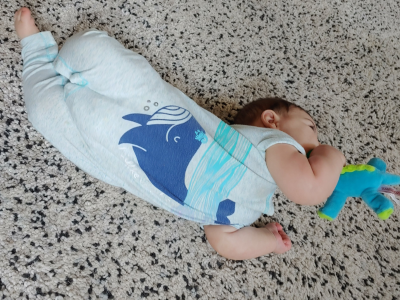Why Rolling Is a Big Deal (and How to Help Your Baby Get There) by Dr. Adrienne McRuvie
By Dr. Adrienne McRuvie B.A., D.C.
Rolling might not seem like much at first glance — just your baby flipping from back to belly or vice versa. But as practitioners who spend a lot of time helping little humans grow strong, we’re here to tell you: rolling is kind of a big deal.
It’s one of your baby’s earliest milestones that shows us their brain and body are starting to work together in all the right ways. Plus, it sets the stage for everything else that comes after — crawling, sitting, walking, climbing... all the things.
So let’s talk about why rolling matters, what it’s telling us, and how you can support your baby’s natural development (without rushing anything).
1. It’s Brain + Body Magic
Rolling is the first time your baby gets to decide how to move their body — not just be moved around by you. Every time they roll, they’re lighting up new connections between their brain and their muscles. Think of it as their nervous system starting to map out how they fit in space.
It’s also how they start to build coordination, balance, and body awareness. These are the building blocks of all future movement — and even things like reading and writing down the road.
2. It Builds Core Strength Without Crunches
From a movement and chiropractic lens, we love rolling because it works the core muscles, back, hips, and shoulders — all at once, and all very naturally. It also encourages spinal movement and rotation, which is super important for healthy posture and mobility as they grow.
If babies skip rolling, or if it’s tricky for them, we sometimes see little signs later like a flat spot, head preference, or challenges with crawling or sitting. Rolling helps prevent those hiccups by getting the whole system moving early on.
3. It Helps With Vision, Balance & Exploration
Rolling isn’t just about the muscles. It’s also how your baby practices using their eyes, ears, and inner balance system. When they look across the room and roll toward something they want, they’re learning about depth, direction, and determination.
They’re also discovering that they can make things happen — which builds confidence and curiosity.
4. It’s the First Step Toward Independence
That first roll is usually followed by a “wait… did I do that?” moment. It’s adorable — and powerful. Rolling helps your baby start to feel safe in their own body and begins a natural path toward sitting, crawling, and eventually walking.
The best part? It’s all happening at their pace, in their way — no rushing needed.
How You Can Support Rolling at Home
Here’s how to help your baby get rolling (pun fully intended):
Lots of floor time — skip the seats, swings, and bouncers when you can.
Tummy time — even a few minutes here and there adds up.
Place toys just out of reach to inspire reaching and movement.
Lie on the floor with them — they’ll often copy you.
Celebrate effort — not just the outcome. Rolling takes practice!
When to Reach Out
If your baby seems stuck, only rolls one way, or isn’t interested in moving much by 6 months — it might be worth a gentle check-in. At Oma, we offer pediatric chiropractic care that supports function, mobility, and natural development (no cracking or forceful adjustments, ever).
We love helping babies move with ease and joy — and we’re always happy to answer your questions.

